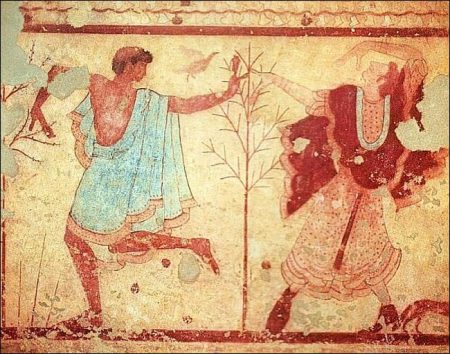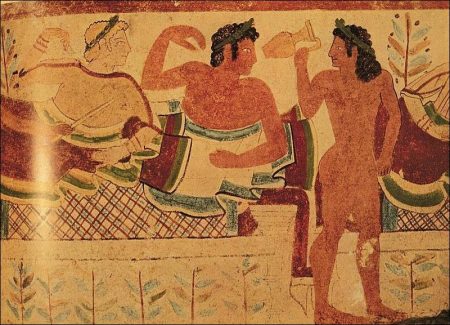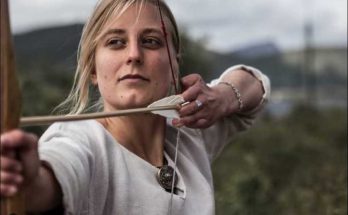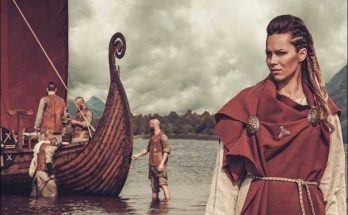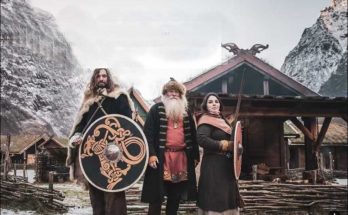The internal walls of Etruscan tombs such as those at Cerveteri and Tarquinii still contain the remains of magnificent murals which give us a considerable insight into the Etruscan way of life. A commonly recurring theme is the banquet, which in the case of the Necropolis paintings, carried a double meaning. For the banquet was also an intrinsic part of the religious ceremony at funerals. After all the formal funeral ceremonies were complete, the relatives of the deceased were treated to a sumptuous banquet, at which the spirit of the departed was believed to attend.
In Etruscan daily life, the banquet was very much a status symbol, indicating to all and sundry that the hosts had “arrived” in the estimation of the Etruscan social elite. Certainly in the heyday of the Etruscan league, around the seventh century BCE a wide reaching trading network (the first EEC) had been well established with far flung parts of Europe.
Etruscan bronzes have been found as far afield as Hassle in Sweden. Ships loaded with amphorae and the bounties of Etruscan mining and agriculture were traded throughout the Mediterranean and possibly into the Atlantic Ocean as far as Madeira. As a result of all this, life for the rich Etruscans was extremely pleasant.
Lavish receptions were laid on, in which the guests; men and women of high social standing, reclined on couches waited on by numerous servants, and were entertained by musicians and dancers swaying to the hypnotic but strident rhythms of music played by Etruscan virtuosos.
The tables were covered with elaborately embroidered table cloths, on to which the various dinner courses were arranged. The dishes included generous selections of fish such as Tuna, and meats such as hare, deer and birds (Wild boar was a particular favourite). Grapes were originally native to the Arabian peninsula, but widely grown by the beginning of the first millennium BCE. The Etruscans probably introduced grapes and wine to Italy around the 9th Century BCE.
Fashion
In the 7th century BCE, Etruscan clothing was very similar to that of the Greek archaic period. The men in the archaic age wore a kind of robe, which was knotted at the front. In later times this gave way to the “tunica” which was worn over the head, usually with a colourful cape slung over the shoulders. This cape, usually wide and heavily embroidered, became the national costume of Etruria – the “tebenna”, later to become the Roman toga.
Women wore a long tunic down to the feet, usually of light pleated material and was typically decorated on the edges. Over this was worn a heavier colorful mantle.
The most common types of footwear were high sandals, ankle boots and one characteristic type of shoe, with upward curving toes, possibly of Greek or Oriental origin.
The most common head wear was a woolen hat, but these came in many different forms such as caps, conical type hats, pointed hoods and wide brimmed hats, such as are still worn to this day by Tuscan farmers. Often the hat identified the person that wore them with a particular social class. From the end of the 5th century BCE, it became more common not to wear a hat. Also from the 5th century BCE men, who previously wore a beard, began to shave and to wear short hats.
The regalia of later Roman times, such as the purple robes worn by the emperors, were of Etruscan origin, as were a number of symbols often ascribed to Rome such as the Lictor and Fasces.
Women wore a great variety of hairstyles including long, shoulder length, knotted or interlaced behind the shoulders, in later times, the hair was worn shorter, and was knotted at the crown of the head or collected in gauze mantles or caps.
The magnificent robes of the patrician women were finished off with exquisite jewellery including ear-rings, necklaces, bracelets and fibulae. In its time, Etruscan Jewellery was unsurpassed by any other in Europe. The bronzes of Etruria were equally celebrated throughout Europe, North Africa and the middle East.
Architecture
Etruscan city planning was on a rigid planning system as determined by the disciplina etrusca. Houses were laid out in streets with sewage lines located under the roads. Early Rome as founded by the Etruscans was laid out in a similar fashion. Following the invasion of Rome by the Celts during the days of the Early republic, the local population begrudgingly rebuilt the city, but the final result was a more hap-hazard street pattern with housing built above sewer lines in many cases, resulting in disease epidemics.
While the Romans are admired for their magnificent aquaducts, the Etruscans reticulated water by means of underground water pipes and pressure boxes- a technology which was not passed on to the Romans. A form of underfloor heating was used, which continued on with the Romans in later years.
The pillars used by the Etruscans to support Temples and other public works complied with defined ratios, and computer models show that in terms of Engineering, they were an improvement on the Greek Corinthian, Doric and Ionian orders.
Arches, unknown in Classical Greece, were originally used in Mesopotamia, and were introduced to Italy by the Etruscans. They were used to good effect by the Romans in later years.
The residences of the Etruscan ruling classes were typically characterised by a wide central courtyard entered from an “Atrium Tuscanicum” as the Romans called it. The word Atrium itself comes from the Etruscan word for entrance or harbour, as in the Etruscan port of Atrii which gave its name to the Adriatic sea.. Several other rooms led off from this central courtyard. The Etruscan villa was the precursor to the later Roman Villa.
The buildings were single storey and were built with blocks of stone as a foundation. The walls were constructed with frames of wood and clay plastering.
The typical shape of the roof was eaved, but terraced roofs were also built. The exterior and interior walls of the houses were frescoed with geometric patterns or with moulded terracotta. Painted scenes adorned the interiors. As in Roman times, it was common to have painted pictures in frame like sections giving an overall effect of pictures hanging on a wall.
Visits: 283
